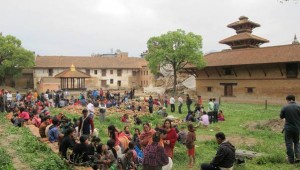Sunday Times 2
Nepal caught unprepared for natural disasters
[KATHMANDU] As international rescue teams struggle to cope with the 7.8 magnitude earthquake which devastated Kathmandu Valley and other parts of Nepal on the weekend, the unpreparedness of this Himalayan country for an earthquake or other major disasters is painfully apparent.
On Sunday, aftershocks continued to shake Nepal for a second day while interior ministry officials confirmed that the death toll had crossed 2,000 and that more than 5,000 people had been injured.
“We have already mobilised rescue teams and helicopters in the affected villages in Gorkha (the epicentre of the temblor) and neighbouring districts,” Laxmi Dhakal, ministry spokesman tells SciDev.Net.
But coping with the devastation in Nepal is an uphill task. Only a week earlier Kathmandu had hosted an international meeting of seismologists and social scientists who pointed to the possibility of a new edition of the 1934 quake that had flattened the city and killed thousands of people.
A study titled published this month (April) in Natural Hazards investigated the structural vulnerability, seismic risk, and economic losses owing to future earthquakes in Nepal using the OpenQuake engineset up by the Global Earthquake Model initiative.
The study says that despite the availability of new data and methodological improvements, the available seismic hazard map of Nepal is about two decades old, calling for an updated seismic hazard model which is an important tool for framing policies on building regulations, insurance, and emergency preparedness.
Geohazards International (GHI), the California-based non-profit which works to prevent deaths and suffering from natural disasters, had published a warning on 12 April that “the 1.5 million people living in the Kathmandu Valley were clearly facing a serious and growing earthquake risk.”
According to GHI, in the absence of any building code, nearly all construction had taken place without consideration of seismic force concerns; and technical information about earthquake risk in the Kathmandu Valley was incomplete and dispersed among several governmental agencies.
To its credit, Nepal had in March inaugurated a humanitarian staging area (HSA) at the Tribhuvan International Airport, Kathmandu, which is now playing its intended role of main logistics hub for airlifted and overland humanitarian assistance entering the Kathmandu Valley.
The HSA is designed to store food supplies for more than 250,000 people for 30 days and has hygiene and sanitation equipment. It can shelter more than 94,000 people and is supported with logistic equipment, mobile storage units, generators, fuel tanks and VSAT connections for satellite phones and internet.
However, Rameshwor Dangal, chief of the disaster management department at the home ministry, had admitted to SciDev.Net two weeks ago that authorities were under-resourced to deal with disasters. “We still have a long way to go before we have hi-tech systems in place for risk assessment and sufficient human resources in the aftermath of large-scale disasters,” Dangal said.
“Having only one international airport is another challenge, so we are also looking at options of implementing contingency plans in regional airports in the future,” Dangal said. In early March, Kathmandu airport was closed for several days after an airliner skidded off the single runway and prevented other planes from taking off or landing.
Saturday’s earthquake also triggered an avalanche at the Mount Everest base camp, resulting in the deaths of several visiting foreigners.
Courtesy scidev.net

